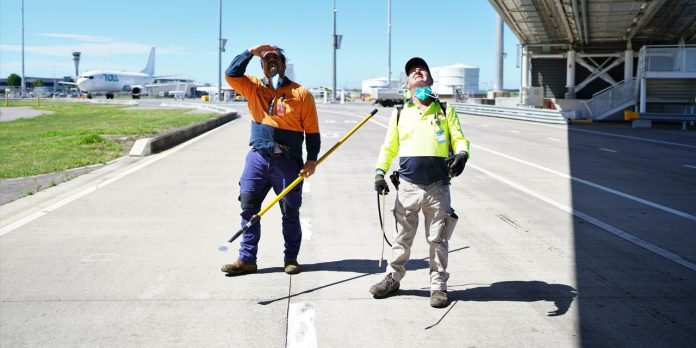BRISBANE, Australia—Each week, employees at one in every of Australia’s main airports spend hours looking out the tarmac and terminals for a safety menace that might carry down an airplane.
The inspectors at Brisbane Airport, in Australia’s third-biggest metropolis, are attempting to find the keyhole wasp, an launched species that builds nests in Pitot tubes—an important instrument on the fuselage that tells pilots how briskly they’re flying. The wasps, which construct nests out of mud, can block a tube in as little as 20 minutes. They’re smaller than comparable native species and have distinctive rings on their our bodies.
“As quickly as you glimpse it, you realize it’s totally different,” stated Phil Watson, who was armed with a sprayer whereas he looked for wasps close to an Emirates A380 jumbo jet on the airport’s worldwide terminal.
The wasps are not any mere nuisance. Within the Nineteen Nineties, a airplane crash that killed 189 individuals close to the Dominican Republic is believed to have been brought on partly by a wasp that constructed a nest in a tube. At Brisbane Airport, there have been greater than two dozen wasp-related security incidents in recent times, together with a 2013 episode when an Etihad Airways flight declared a mayday and returned to the airport after a wasp nest obstructed a tube.
Now, after years of examine, authorities in Brisbane imagine they’ve an answer that might function a mannequin for different airports. They are saying an insecticide primarily based on a South American plant is efficient at eliminating caterpillars which are a meals supply for the wasps, and that they’ve lowered the variety of wasp nests by a median of 64%. They’re increasing the grassy areas handled by the insecticide to take out extra caterpillars and decrease wasp exercise even additional.
A airplane with purple covers over its Pitot tubes.
“We haven’t eradicated all wasps at this stage, however that might be the endgame,” stated Tom Ashover, wildlife administration and planning coordinator on the airport.
Airports normally concentrate on maintaining away birds, which might collide with plane engines in flight and have brought on high-profile accidents, equivalent to the 2009 disabling of an Airbus A320 airplane that needed to land within the Hudson River off Manhattan. But when left unchecked, wasps and different bugs might be an rising problem, as efforts to cut back air pollution and develop quieter and cleaner plane make airports extra engaging to wildlife. Local weather change may additionally immediate species to broaden to new areas.
“This wasp will inevitably unfold,” stated Phil Shaw, founding father of Ecosure, an environmental consulting agency that helped the Brisbane airport examine the wasps. “I’ve little doubt they’re already popping up in new places.”
Within the U.Ok., regulators concluded {that a} comparable sort of mud-nesting wasp, in addition to bees, have been responsible for blockages in Pitot tubes final 12 months at London’s Heathrow Airport. A number of plane have been affected throughout late spring and early summer season, leading to aborted takeoffs in two instances.
The aviation slowdown throughout the Covid-19 pandemic, which largely grounded air journey, probably resulted in a surge of insect exercise, provided that there was much less noise and jet efflux to discourage bugs, the regulators discovered. In response, the airways started utilizing extra covers on the Pitot tubes and one operator began detailed visible inspections. Heathrow, which has since launched insect monitoring, says there haven’t been any blockages this 12 months.

A keyhole wasp at Brisbane Airport.
Photograph:
Brisbane Airport
Points have additionally arisen in Hawaii, the place the identical keyhole wasp has been discovered. In 2016,
started requiring Pitot tubes to be coated quickly after arrival at Honolulu to discourage wasp nesting, although it couldn’t make sure which species of mud-nesting wasp was responsible.
Protecting the Pitot tubes isn’t a foolproof answer. Though Australia’s aviation-safety authority final 12 months issued an advisory recommending that the tubes be coated, that provides one more process for busy floor crews. In Might, a
flight at Brisbane almost pushed again from the gate with the covers nonetheless on.
It took some scientific detective work in Brisbane to find out which species was chargeable for all of the tube blockages. Researchers printed 3-D fashions of assorted Pitot tube designs, positioned them across the airport and noticed which wasps have been making properties inside. The keyhole wasps, native to Central and South America, in all probability unfold to Australia as larvae in nests connected to delivery crates, in keeping with an article printed in a scientific journal.
Wasps just like the Pitot tube as a result of they’re sufficiently small to be enclosed by mud, however large enough for wasp larvae. Earlier than laying eggs and sealing up the nest, an grownup wasp will discover a caterpillar, paralyze it, and deposit it reside within the nest, offering the larvae with prompt meals. When the larvae mature into adults, they open up and emerge from the nest.



High: Pest inspector Geordie Ryle factors to holes in concrete as he searches for wasp nests. Backside: Tom Ashover (left) holding specimens of the keyhole wasp. Pest inspectors say the airport grounds present many potential spots for wasps, which favor small openings, to construct nests. Mike Cherney/The Wall Road Journal
“It’s like having Domino’s pizza on faucet,” stated Nick Bloor, chief government at IVM Group, a vegetation-management firm that’s working with the Brisbane airport. Mr. Bloor stated the insecticide being sprayed solely impacts sure bugs, with little impression on mammals and low toxicity to birds, fish and bees.
Regardless of all that progress, the wasps can nonetheless be ready within the wings for a comeback. Earlier this 12 months, nests have been discovered close to a few gates at Brisbane’s worldwide terminal, sparking considerations that plane may as soon as once more be in danger.
Officers on the airport zeroed in on a close-by patch of grass that hadn’t been handled with the caterpillar-targeting insecticide, as a result of it was near a building web site the place employees have been busy fixing pavement.
“It was a thriller,” Mr. Bloor stated, including that the realm is now being handled. “We are able to ensure we be taught from that.”
Future analysis may reveal issues with any insecticide, however there aren’t any present purple flags with the one getting used on the airport, stated Jonathan Larson, a pest-management knowledgeable and assistant professor on the College of Kentucky. Mr. Larson, who isn’t working with the airport, stated it’s a distinctive technique to go after the meals supply, slightly than the wasp itself.
“With an invasive species, with human lives on the road, and such a specialised drawback, you actually are largely the one choice being some kind of insecticide,” he stated.
The airport is utilizing monitoring stations to seize moths—the grownup type of the caterpillars—to match insect populations in untreated and handled areas. In the meantime, Mr. Watson and his colleague Geordie Ryle are recording any wasp nests they discover, which permits the airport to trace wasp exercise over time.

Tom Ashover, left, with Nick Bloor at an insect monitoring station.
Photograph:
Mike Cherney
Mr. Watson, who works for Flick Pest Management, stated the wasps prefer to nest in lots of small openings, together with recessed bolt heads and holes in concrete, notably if there may be shade to guard from the warmth. Throughout their current shift, Mr. Watson and Mr. Ryle discovered two previous nests close to jet-bridge wheels, near the place the A380 was parked.
“There’s so much to examine,” stated Mr. Ryle, including that some areas, like beneath jet bridges, are robust to achieve. “However you’ve received to try to get all of it.”
Write to Mike Cherney at mi**********@ws*.com
Copyright ©2022 Dow Jones & Firm, Inc. All Rights Reserved. 87990cbe856818d5eddac44c7b1cdeb8























